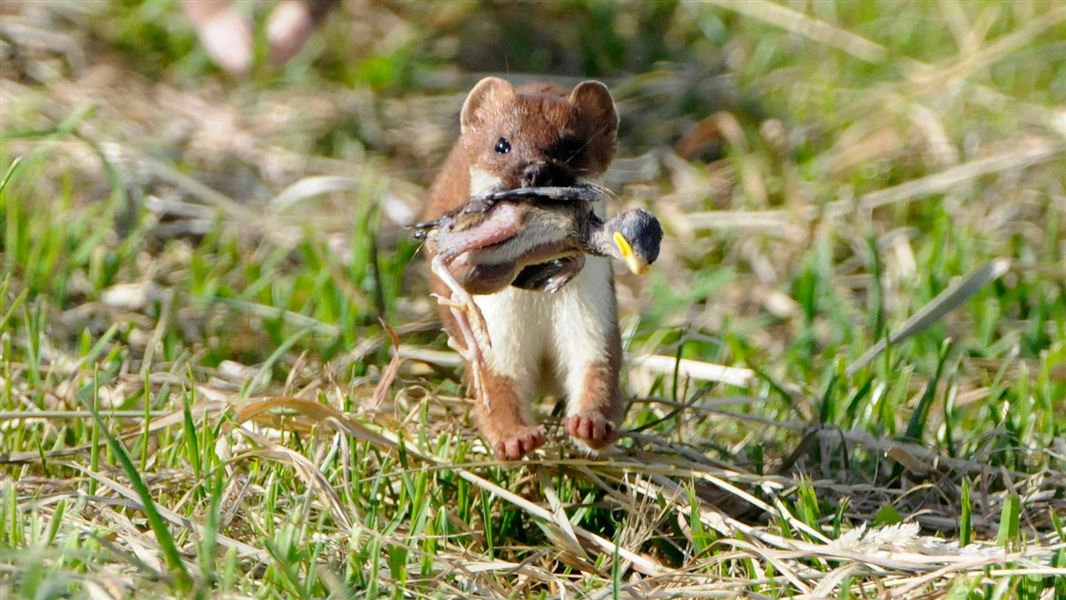Description
Stoats (Mustela erminea) are members of the mustelid family. Weasels and ferrets are also mustelids. All three species were introduced to New Zealand as early as 1879 to control rabbits that were destroying sheep pasture. From very early on, stoats have had a devastating effect on New Zealand’s unique birdlife.
A stoat has reddish-brown fur on its back, a white or cream coloured underbelly, and has a long tail relative to weasels, with a distinctive and obvious bushy black tip. An adult male can measure 390 mm from nose to tip of tail. Stoats can be confused with weasels but adult stoats are longer and heavier than adult weasels and display a straight line along their sides where the brown fur meets the pale belly fur.
Stoats live in any habitat where they can find prey. In New Zealand, they are found anywhere from beaches to remote high country, at any altitude up to and beyond the tree-line, in any kind of forest – exotic or native, in scrub, dunes, tussock, and farm pastures. They are known to live near human settlements.
Stoats are agile climbers, and hunt at any time, day or night. They are known to be able to swim across water gaps of up to 1.5 km to reach islands. A stoat may be able to reach land at a greater distance than it can swim by ‘rafting’ on floating material such as driftwood logs.
Den sites are well hidden and are taken over from other animals. They include holes in tree trunks and rabbit burrows. Stoats disperse freely and individual juveniles have been known to travel over 70 km in two weeks.
The threat
The effect of stoat predation on the survival of many of New Zealand’s bird species cannot be underestimated. They are voracious and relentless hunters, described as having only two reasons for living – to eat and to reproduce.
Stoats are known to be having a significant effect on birds species such as wrybills, the New Zealand dotterel, black-fronted terns and young kiwi. Birds that nest in holes in tree trunks such as mohua, kākā and yellow-crowned kākāriki are easy prey for stoats who can take out eggs, chicks and incubating adults in one attack.
Stoats are implicated in the extinction of South Island subspecies of bush wren, laughing owl and New Zealand thrush. Even a 3 kg takahe or 2 kg kakapo can be killed by a stoat, that also has a strategy of killing everything in sight and storing the surplus for later.
Stoats and rats are part of a complex predator-prey relationship associated with beech tree seed production. In a periodic ‘mast event’ of beech trees – where high levels of seed production occurs – stoat populations explode assisted by the increased food supply. Later, when the seed supplies run out, the higher numbers of predators have an even greater effect on populations of birds, wētā, bats and land snails.
This video shows stoats eating rock wrens in the Upper Hollyford Valley, Fiordland. Every rock wren nest that DOC monitored that year failed, and predation by stoats was the primary cause.
You can help to control stoats
Regular predator control will help to control stoat numbers and get us closer to the Predator Free 2050 goal.
Stoats and other introduced predators threaten our treasured animals and plans. Every New Zealander can make a difference in getting us closer to our Predator Free 2050 goal. Get involved by joining your local community group, trapping on your property, or getting the whole whānau involved.
See Predator Free 2050 Trust - get involved for information.
National Predator Control Programme
To protect our native wildlife, DOC's successful predator control programme helps control the pest numbers and prevent predator plagues.
Every few years, beech forests drop trillions of seeds in a mass seeding event known as a mast. The abundance of seeds fuels a surge in rat and stoat populations. If we did nothing during a beech mast, precious native birds, lizards, bats, and insects would be devastated by predators. Wildlife such as mohua, kākā, whio, kiwi, bats and land snails are particularly vulnerable to stots, especially when their numbers skyrocket during a mast.
